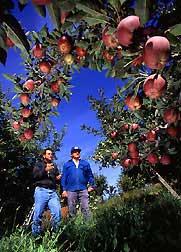The Domestic Apple
"An apple I took from the tree,
God had it forbidden me,
Wherefore I should be damned."
-Mogan, pg.34, 1993

"The Lord is good to me,
And so I thank the Lord:
For giving me the things I need
The sun and the rain and the apple seed..."
-Anon: a grace
Perhaps no fruit has experienced as much fame and cultural representation as has the apple.
The origin of Malus X domestica can be traced back to the foothills of the
Russian/Chinese border. These temperate forests stretched all the way to the Black
Sea and provided a perfect growing environment which comprised ample water as well
as a winter chill that is necessary to bring seeds out of their dormancy. Today
apples are farmed extensively throughout the world. In 1999, there were over 7 million
hectares of apples farmed, including 27 thousand ha within Canada (courtesy FAOSTAT).
An important technique in the cultivation of apple trees is known as 'grafting'. This process includes the binding of a cutting (called a "scion") into the cleft of a sapling (called a "rootstock"). The scion is a cutting from an apple tree with desirable fruit and the rootstock may be any type of apple tree at all. Only the scion's fruit will be present on the mature tree.
Often promoted for its health benefits, resent research has shown apples to be rich in flavonoids which may have anti-cancer effects on the human body. After all, "an apple a day, keeps the doctor away. "
Contributed by Steven Gates
Photo source: ARS Image Gallery